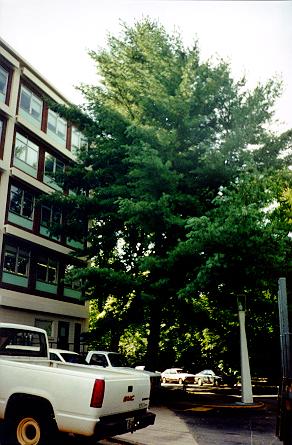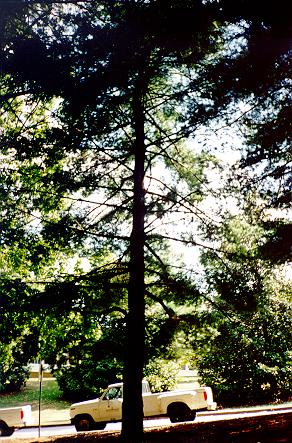
Picture of Pinus strobustaken outside of the Biology building by Carissa Klatka.
author: Carissa Klatka
e-mail address: clk@arches.uga.edu

Picture of Pinus strobustaken outside of the Biology building by Carissa Klatka.
Higher Taxa:(Vidakovic, 1991)
IDENTIFICATION:
P. strobus has slender needles in clusters of 5 that grow up to 12 cm long. The outer surface of the needles is gray-green, and the inner surface is gray-white. Branches are usually in horizontal whorls, with one whorl being produced a year.(Duncan and Duncan, 1988) The bark is smooth and greenish brown. In early summer, yellow pollen-producing blossoms can be seen on young shoots of the lower branches, and small pink "cone-bearing ovulate flowers" appear on the upper shoots. These cones hold the seeds until they are released in the next year's fall.(Collingwood and Brush, 1978)

Picture of Pinus strobus taken outside of the Biology building at UGA by Carissa Klatka. Notice the whorls of horizontal branches.
HOW TO ENCOUNTER:
These trees survive best on "deep sandy looms" (Collingwood, 1978), but will grow in many types of soil with adequate moisture. They can be found living with hardwoods, hemlock, and red pine. P. strobus is native to Eastern North America.(Coombes, 1992) However, a variety of P. strobus grows in mountains of southern Mexico and Guatemala(Duncan and Duncan, 1988)
ENEMIES:
White Pine Rust is a disease-causing fungi that lives as a parasite on P. strobus, as well as other pine trees. A branch or trunk is infected, swells, and becomes discolored. The rust consumes all living tissues. Older trees can escape death if the rust consumes the upper part of the tree, and that part dies while the lower sections survive. (Pielou, 1988)
The White Pine Weevil is another pest that invades P. strobus. They do not usually kill the trees they attack; they just kill the terminal shoot of the stem, above all side branches. The tree will stand crooked if only one side branch is affected with the side replacing the orginal leater (terminal shoot). If multiple side branches become leaders, the tree becomes forked. (Pielou, 1988)
INTERESTING FACT:
P. strobus was named the official tree of Ontario. It was given royal assent on May 1, 1984. Please visit a web site by the students of Chapel Hill Catholic School in Gloucester, Ontario, Canada.
HISTORY:
P. strobus was discovered by Linnaeus.(Grimm, 1983) Early colonists in America used the shape ofP. strobus to decorate historic flags. (Mirov and Hasbrouck, 1976).The inner bark of P. strobus used to be used by the Indians for food, and has also been used to cure coughs. Rabbits use bark from young trees for food, and seeds are eaten by squirrels and various birds.(Grimm, 1983) These trees are some of the most valuable lumber trees, but soft white pine wood that is easily worked has become scarce, so many trees in the north are pruned used for ornamental use.(Duncan and Duncan, 1988)
GEOGRAPHY:
Pinus strobus | ||
| AREA | STATUS | REFERENCES |
| North America: Continental United States; Canada |
Yes | Duncan and Duncan, 1988 |
| Eastern North America: United States east of Mississippi; Ontario and eastern Canada |
Yes | Duncan and Duncan, 1988 |
| Southeastern United States : AL AR DE DC FL GA KY MD NC SC TN VA WV |
Yes | Duncan and Duncan, 1988 |
| Southern Appalachian
States: AL GA KY MD NC SC TN VA WV |
Yes | Duncan and Duncan, 1988 |
| Coastal Plain | Probably Not | C. Klatka, Personal Guess |
| Piedmont | Yes | Duncan and Duncan, 1988 |
| Blue Ridge Mountains | ? | - |
| Great Smoky Mountains National Park | Yes | Duncan and Duncan, 1988 |
| Ridge and Valley | ? | - |
| Cumberland Plateau | No | Collingwood and Brush, 1978 |
| Central Arch | No | Duncan and Duncan, 1988 |
| Georgia | Yes | Duncan and Duncan, 1988 |
| Clarke County, Georgia | Yes | C. Klatka, Personal Observation |
| Sam's Farm | Probably | C. Klatka, Personal Guess |
| Old Field | Probably | C. Klatka, Personal Guess |
| Wetland | Probably Not | C. Klatka, Personal Guess |
| Woods | Probably | C. Klatka, Personal Guess |
| 1-Hectare Plot | No | C. Klatka, Personal Observation |